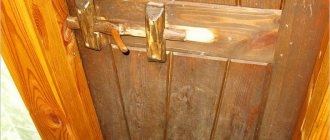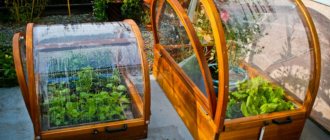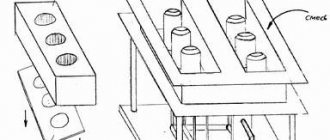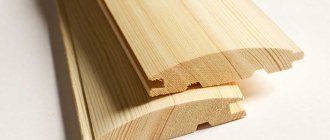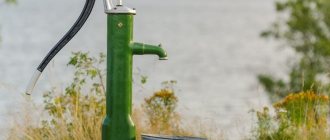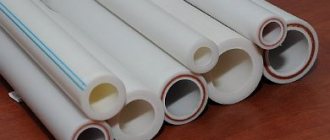Many aspiring entrepreneurs consider organizing a mini dairy farm as an excellent prospect for starting their own business. The popularity of this idea is easily explained:
Ready-made small mini farm project
- A mini-farm requires a small production area.
- Family farms require smart investments.
- Maintenance of a mini-farm requires minimal costs.
The project of a modern farm for 50 or 100 heads will provide all family members with permanent work and stable good income.
What building materials and tools are needed?
First of all, it is necessary to decide what building materials to use for the construction of the barn, since this determines: how quickly the construction will take place, how reliable and durable the structure will be, and how comfortable the animals will be in it.
Buildings in the construction of which concrete was used did not justify their worth, since they have increased thermal conductivity. During the summer months, it is very hot in such a barn, and during the cold season the heat does not stay inside the building. The use of wood is more expedient, since this material has low thermal conductivity. Although there are some disadvantages: the material is fragile, fire hazardous, the boards can rot, and their cost is quite high.
Brick is successfully used in the construction of mini-farms. This building material is capable of excellent heat retention and excellent protection from outside noise.
It is not advisable to use bricks for the construction of a large complex for keeping cows. In this case, it is better to use modern SIP panels (sandwich panels consisting of slabs with insulation between them). This building material is characterized by quick construction, relatively low cost, and excellent thermal insulation.
What is a must-have on a farm?
After moving out the “box” of the building, it’s time to start equipping it. In order to create comfortable conditions for raising cattle and comply with all established sanitary standards, the building must provide:
- Ventilation system. It is needed because waste products release carbon dioxide and ammonia into the air. You can install natural ventilation by installing ventilation curtains or a light ridge, or forced ventilation by installing fans and valves.
- Lighting system. In addition to window openings, the installation of lighting fixtures with fluorescent or LED lamps is required. During the daytime, illumination should be maintained at 200 lux, and at night, low-power lamps that glow red should be used.
- Appropriate microclimate. During the hot season, the temperature in the barn should be maintained within +8-22 degrees using cooling radiators or fans. And in the cold months, especially at extremely low temperatures, you can use infrared heating, blankets for cows, or heat lamps for babies to warm the animals. Hygrometers should be installed in rooms to measure humidity levels. To reduce the impact of external noise on livestock, sound insulation is carried out.
- Containers for food and drink. You can get one in a specialized store or build it yourself. An automatic drinking bowl made of stainless steel with a self-cleaning function is considered comfortable. As for feeders, they should be separate for dry and wet food.
- System for disposal of livestock waste products (mechanical removal using scraper-conveyors, underground storage, use of hydraulic and gravity technologies).
Phased construction: drawing
Before construction begins, there are some steps that need to be taken. Any structure needs calculation and planning. First you need to create a detailed project diagram based on all available data. Then, according to the plan, the building materials and costs required for construction are calculated. A well-executed preparation phase greatly facilitates construction. After this, you can begin to choose the location where the building will be located. It must meet some requirements:
- The distance to residential buildings must be at least 15 m.
- The well or borehole must be located more than 20 meters away.
Made of brick, adobe
Adobe (raw brick) is made from a mixture of clay, straw and sand. The most budget option for construction, because its components can be found in any household. Building a barn with bricks is profitable, but often expensive, and not everyone can afford it. However, during construction they try, if possible, to make the floor or walls of brick. It is durable, strong, and can protect against frost and fire. Brick flooring is warmer than concrete and more stable than wood. The minimum service life of a brick floor is 10 years. In areas with low temperatures during construction, brick walls must be laid out in two rows with insulation laid between them. This significantly increases construction costs.
From sandwich panels
Sandwich panels have lower conductivity than brick. The protective coating of the panels increases resistance to aggressive environments, which extends their service life. If you have a ready-made foundation, a barn made of sandwich panels can be assembled by a couple of workers in a few weeks. Windows in such a structure are also made of this material. The panels are lined on both sides with treated steel, which can be painted if necessary.
An example of a barn construction diagram.
Do-it-yourself prefabricated
Prefabricated barns are manufactured according to special drawings. The longest stage of such construction is the assembly of the finished structure. It may take two to three months. This type of barn is distinguished by its special appearance, durability and strength. Sandwich panels or sheet steel are usually used for external and internal cladding. The material is additionally treated with a special compound to prevent corrosion. With proper design, such barns can increase labor productivity.
You can learn about rubber mats for cattle here.
How to obtain a building permit?
A simple way is to enter into an agreement with a construction company that will do all the necessary work. The main thing is to carefully read the terms and conditions specified in the contract. You need to work exclusively with professionals to avoid future problems. Also during the construction process, the requirements put forward by environmental, sanitary and fire services should be taken into account.
To obtain permission to build a livestock farm, the customer must send the following documents to the administrative authorities:
- a diagram of the land plot where the construction of the object is proposed with the obligatory designation of places of archaeological heritage, if any;
- diagram of the land plot with the location of the facility up to the red line;
- data regarding engineering structures indicating the site plan and connecting the facility to engineering supplies.
In addition, the following must be provided:
- statement;
- documentation confirming the right to use the land plot;
- design of architectural buildings.
Administrative authorities may not make a decision in your favor if there is a discrepancy with the project regarding the use of the land plot or if deviations from the prescribed norms and rules are found.
Summary:
1. investments - 5,585,000 rubles.
2. payback period – 32 months.
3. average monthly profit - 176,666 rubles.
Sources
- https://business-poisk.com/biznes-plan-molochnoj-fermy.html
- https://to-biz.ru/kak-otkryt-molochnuyu-fermu/
- https://vipidei.com/proizvodstvo/vyrashhivanie/otkrytie-molochnoj-fermy/
- https://agrobuilding.com/objects/livestock/barn/stroitelstvo-molochnoj-fermy-investitsii-i-okupaemost
- https://biznesovo.ru/biznes-plany/biznes-plan-molochnoj-fermy
- https://www.beboss.ru/bplans/185-biznes-plan-molochnoy-fermy-na-100-golov
- https://Proekt-sam.ru/proektzdanii/proekt-mini-fermy.html
- https://pokras-stroy.ru/ferma-dlya-krs-na-50-golov
- https://pokras-stroy.ru/stroitelstvo-molochnoy-fermy
- https://mirfermera.ru/688-tipovoy-proekt-korovnika-na-50-golov.html
- https://molferma.com/sozdanie_mol_fermi/stroitel-stvo-sovremennoj-molochnoj-fermy-kak-postroit-korovnik.html
- https://pokras-stroy.ru/kozya-ferms-na-50-koz
- https://BusinessXXL.ru/molochnaya-ferma/
Dacha as a source of income
Nadezhda is a civil engineer, her husband is a miner and their sons live in a small town 30 kilometers from long-suffering Donetsk. When retirement loomed on the horizon, the family began to look for new ways to earn money. They had one resource for this - a dacha. They bought their neighbors’ abandoned plots, cleared them of overgrowth, and received 30 acres of land. We built a barn, bought two Vietnamese pigs and a wild boar and two month-old female goats.
NadWas
The goats grew up, gave birth, and by the time we retired we already had four goats. Vietnamese pigs regularly brought us piglets, which we successfully sold online.
At first, the animals were raised only “for themselves,” then a neighbor asked to sell milk for his grandson. I liked the milk and started buying more. Other summer residents followed him. Good, full-fat milk was sold out and there was nothing left for ourselves. We bought another plot of land, built another barn, and doubled the number of goats.
It turned out that goats are the most profitable animals.
The pigs were replaced with California rabbits. We got chickens: Cochins, Amroks and Kuchins. Sometimes the sounds of bombing were heard at the dacha, and for the New Year they made a wish “So that they don’t shoot anymore,” but worries distracted us from painful thoughts.
Choosing the right place
To build a farm for cows without any problems, you need to choose the right piece of land. This should be a flat and well-trodden area. The presence of a small forest belt near the mini-farm will protect animals from drafts and/or strong winds.
Natural reservoirs and/or sources of drinking water, according to the legal norms of the relevant laws of the Russian Federation, must be at least 30 m away from places where mass livestock are kept, otherwise the owner may be fined a large amount. In this case, the mini-farm will have to be moved to another site.
An equally important point is the absence of residential and/or other buildings near the place where the mini-farm will be set up, cattle - this is an inevitable unpleasant smell. You should not create discomfort for residents of nearby settlements. On its own site, a mini-farm for cows is set up closer to the place where fruit and vegetable crops are planted. This will make it easier to use manure to fertilize the soil. A modern farm should be located at a distance of 15 meters or more from a residential building. Additionally, the main wind direction in the region should also be taken into account.
To build a farm for cows without any problems, you need to choose the right piece of land
Distinctive features of free-stall farms
Although many dairy farms use tether housing, today farmers are increasingly switching to free-stall systems. In such a situation, the cow is in a separate box, which is an area fenced on three sides with a floor raised in relation to the passage by 15-20 cm. On such a farm, there are boxes where cows rest, combined boxes with containers for feed, and specially equipped platforms for milking.
The animals themselves approach the food containers. Feces are removed from the passage by a wheeled tractor equipped with a bulldozer shovel. The advantage of untethered technology is higher worker productivity. This is possible thanks to group housing of livestock, saving time and the use of equipment for automatic feed distribution and water supply, and automatic milking.
Why build a barn
The answer to this question is quite obvious, but we will voice it anyway. The main purpose of the barn is to create suitable conditions for keeping livestock.
As a rule, cowsheds are built at large specialized enterprises and farms, since they are not particularly needed in other domestic situations.
The easiest way is to hire workers to do the work for a certain amount. Do-it-yourself construction can be cheaper and help save money, but at the same time it will require more effort and time.
Based on this, it’s worth starting by prioritizing and deciding what is more important: money or your own strength. If you are firmly convinced that money is still more important, you can safely start planning.
How to choose materials for building a barn
First of all, you need to take care of materials for construction. Now we will present several options and list their advantages and disadvantages:
- Concrete.
- Tree.
- Brick.
- Sandwich panels.
- Slag blocks.
Concrete was traditionally used in the construction of cowsheds back in Soviet times, which, as it became known in practice, was a big mistake. The problem is concrete's high thermal conductivity - its ability to conduct heat.
Because of this key property of building materials, heat quickly leaves the building in winter, and in summer, on the contrary, it easily penetrates inside, and this creates extremely uncomfortable conditions.
It is worth adding that the premises are poorly ventilated in winter, creating good conditions for the emergence of bacteria leading to various diseases of livestock. This problem cannot be solved simply by opening windows and doors more often, because frosty air will also negatively affect the health of animals.
Unlike concrete, wood has low thermal conductivity and retains heat much better. There were also some shortcomings here, so wood was considered a good material, but short-lived. This is explained by the fact that the most trivial fire can easily destroy a wooden building.
It is also prone to rotting, but time and experience have shown that with a properly organized ventilation system, this, like other troubles, will not threaten you. The main thing is to carefully control the humidity level and follow basic rules.
Brick has gained the greatest popularity as a building material, which has been used for many years in countries located in temperate climate zones. A brick barn will be guaranteed to be strong and will serve you for a long time.
Sandwich panels have good competitiveness, although they are not as well known as the materials listed above. They appeared not so long ago, but have already proven themselves to be durable. Sandwich panels are advantageous as building materials because buildings made from them can be erected quickly and easily—two weeks is enough.
But we have not yet answered the main question - by what criteria to choose building materials? This question is directly related to the purpose of the building. We have already figured out the purpose of the barn - keeping cattle. In this case, one of the most important criteria will be thermal conductivity, because the temperature in the room and the well-being of the animals depend on it.
Designing a Cow Barn
Construction starts with drawing up a plan. Adhering to the requirements and advice, you should draw a floor plan and try to detail it as much as possible, not forgetting such important nuances as the ventilation system.
If you don't have any special requirements, a quality plan can be found online. However, it is recommended to do this yourself, adapting to the terrain.
The value of the plan when building a 20-head barn with your own hands is that this is a serious and quite large-scale project, and it should be approached with all responsibility.
It’s worth starting with calculating the area. You can take the size of the stable according to standards as a basis. In addition, you need to rely on the fact that an adult requires about twenty cubic meters, and a young one - ten.
There are a few other aspects to consider:
- food storage space;
- location of relevant equipment.
We legalize your business: state registration
Officially, a farm from scratch begins with state registration of the enterprise.
Every farm owner is required to legitimize his business by opening an individual entrepreneur or LLC. Most often, the first option is chosen as it is simpler and more profitable in terms of taxation.
If you plan to supply products to retail chains, first get the go-ahead from Rospotrebnadzor and firefighters. You will also need a land lease agreement.
Since food is produced on farms, the owners must have documents confirming its decent quality. If we are talking about meat production, it is necessary to obtain a veterinary examination.
How to keep livestock using the tether method
The economic farmer takes care of his livestock. If you use the untethered method in a hangar, then the building should:
- connect to the water supply and electrical network;
- maintain special equipment that monitors the well-being of animals and the indoor microclimate;
- be with an area of at least 1000 m²;
- the height of the room must be above 6 m;
- for 50 cows, the size of the hangar should be 15x70 m.
Important! It is worth considering which products will predominate: dairy or meat. With the free-stall method of obtaining milk, when cows have free access to the feeder and can also walk, milking is done in a special room
The main technology for collecting milk is carried out in:
With the free-stall method of obtaining milk, when cows have free access to the feeder and can also walk, milking is done in a special room. The main technology for collecting milk is carried out in:
- boxing;
- combibox;
- on deep litter that does not change.
The advantages include:
- high efficiency;
- improved working conditions;
- good handling of livestock.
Of the minuses:
- animals become just a herd, without nicknames;
- they fight for food and water;
- the amount of feed consumed increases;
- Additional requirements apply to animals.
Additional Information! A dedicated milking parlor uses either a herringbone or tandem approach. The length of the milk pipeline is reduced by 5 times, which improves the quality of the dairy product and also provides the required sanitary care.
To keep cows free-stall, the following conditions must be met:
- ensure separate maintenance of livestock;
- eliminate the disorderly movement of milked and unmilked cows;
- ensure the passage of milked animals to the paddock or to the feeding trough.
This method guarantees an increase in milk yield and faster weight gain for animals. The cattle stands in its own compartment, which has an area of up to 2.5 m². Here she lies, relieves her natural needs, and has access to a feeding trough. Almost all large farms use this method.
The disadvantage is the need to increase the labor force to feed the animals, clean up after them, as well as veterinarians to monitor the health of the animal, since chronic diseases develop in sedentary cattle.
Pros:
- animals do not collide and are not injured;
- each animal receives as much feed as it needs, the stronger animal does not eat the weaker;
- feed consumption is reduced by 10%, which is beneficial for the farmer;
- It is easier for veterinarians to monitor each animal;
- the cow produces 20% more milk, and the calf gains weight 15% faster;
- milking cows is easier.
Note! If you build stalls in a barn correctly, urine and manure will flow outside the barn. There is a standard way of milking in a special milking parlor
In this case, the cows have an automatic tether, but it can also be semi-automatic. This doubles the productivity of milk production
There is a standard way of milking in a special milking parlor. In this case, the cows have an automatic tether, but it can also be semi-automatic. This doubles the productivity of milk production.
Note! In addition, the cows pass through the wash, which ensures the purity of the product.
How to build a farm for cows?
Cattle farming, where farm animals are raised, provides an opportunity for financial profit. First you will have to buy a couple of dairy cows. And over time, the herd size will increase, which will contribute to the growth of business profitability.
But before you decide to start farming for profit, you need to carefully weigh the pros and cons.
To build a mini-farm for cattle, you will first have to resolve the following issues:
- select a site for a barn;
- purchase or lease a plot of land;
- acquire the necessary tools;
- purchase several heads of livestock of both sexes;
- create certain conditions for keeping each individual;
- maintain cleanliness in areas where animals are located;
- clean up manure.
It should also be taken into account that when running a farm you will have to incur considerable expenses for:
- purchasing building materials for a future farm;
- construction, to hire specialists, since all the work must be done with one’s own hands (for example, assistants are needed to erect a roof);
- purchasing and transporting cows;
- hiring workers to care for animals (the farm owner can handle 1-2 animals on his own, but if the herd size reaches 10 animals or more, he is unlikely to be able to do the work without outside help);
- feed purchases;
- payment for veterinary services.
Over time, when the farm is already operating at full capacity, profit can be received from sales:
- meat and milk;
- skins;
- bulls and heifers;
- livestock feces as fertilizer.
In addition, even mating can bring profit if you have a stud bull on your farm.
Equipment and interior design
It is important not only to build a barn correctly, but also to carefully consider its internal arrangement (Figure 4). To maintain livestock productivity, you need to draw up a plan for the location of animals in advance so that there is enough space for the entire livestock
In addition, the interior of the building must be properly treated to prevent animals from suffering from mold, mildew, or drafts.
If we talk about the general rules for the internal arrangement of a barn for 50 heads, then the main nuances will be as follows:
- The size of the stall for one adult should be 1.7 * 1.1 meters. However, if you plan to keep cows with calves, the area of one compartment needs to be increased.
- It is better to make the floor wooden, since the concrete surface is too cold and can cause colds in cows. It is advisable to use sawdust or straw as bedding, and this covering should be changed regularly as it gets wet.
- A chute is installed at the rear of each stall to drain slurry. It should be built in such a way that the gutter has a slight slope towards the collector or cesspool. This will make your work easier, since the waste products of livestock will gradually flow into the pit. At the point where the chute exits the barn, a small opening is made in the wall and covered with a valve.
- In the front part of the stall there is a feeder and a drinker. The simplest model of a feeder is a trough with sides. Such a product can be easily made with your own hands from planed and sanded boards.
- If you plan to keep cows and calves together, next to each stall you need to build a small compartment or cage in which the young animals will be kept.
Compliance of the internal space with sanitary and hygienic standards also plays an important role in maintaining the health and productivity of cattle. The problem is that pathogenic microorganisms actively develop in the barn environment. To prevent this, you need to regularly clean the premises, remove residual manure from gutters and change the litter. In addition, immediately after the construction of the building, it is necessary to plaster the internal walls and whitewash them with lime. This substance has antibacterial properties and prevents the development of fungi and mold inside the barn.
How to calculate sizes?
Taking into account the established standards for breeding farm animals, the area of the floor in the pen for one individual should be approximately 5-6 m2. And if we take into account future offspring, the size of the stall increases to 10 m2.
On average, the pen should reach 170 cm in length and 110 cm in width. Parameters may vary depending on the live weight and dimensions of the animal. The floor in the stall should be sloping in the direction of the chute for collecting feces, which is calculated as follows: 2 cm per 1 meter of pen length.
Important! The width of the sewer drain should be at least 30 cm so that it is convenient to clean it with a shovel.
The width of the stall should be at least 1.8 times the width of the individual in the area of the hips (hooves). In this case, the animal will be able to lie down or rise without hindrance.
But regarding lighting, one stall requires approximately 1 m2 of window opening. The window size should be 50 cm * 70 cm. The ceiling in the room for keeping cattle should be at least 3 meters above the floor, and the curbs should reach 15-20 cm in height, so the cow will not partially occupy the passage in a lying position. The walls between the pens are most often made at 2/3 of the length.
Equipment
Rubber mats
Rubber mats for cattle are cheaper than polymer mats for cattle, and the quality leaves much to be desired. They are not shock-absorbing and do not protect the cow well from the cold.
Important! The thermal conductivity of rubber is 5 times lower than that of polyurethane. Therefore, you also need to lay sawdust or straw on top of rubber mats for cattle to make the animal warmer and softer
At the same time, a rubber mat for barns has a number of advantages:
- does not deform;
- serves for 2-3 years;
- safe from an environmental point of view;
- the animal does not slip on it, which means it is not injured.
For cows, the rubber mat is sold in different sizes: 120x180 and 90x160 cm. Its weight is up to 25 kg. There are holes for mounting in the barn. Thanks to a special tape, manure and urine do not get under it.
Rubber mat
Animals like to lie on cow bedding that contains bacteria. It is irreplaceable and lasts for a year and a half. Reduces costs for the farmer, as fewer employees are required to care for the livestock, and there is no need to add straw or sawdust.
Comber and brush
Thanks to the cow scratcher, the animal feels happy and even produces 3.5% more milk. The brush also helps keep the animal clean.
Cow brush
Headlocks
A modern cow farm is indispensable without headlocks for cows. The parts of the tool are made of plastic, so there is no noise from slamming.
Drencher
Using a cow deluge allows workers to infuse liquid into the animal quickly and efficiently. With this device you won't have to carry water in buckets. You just need to bring the hose to the cattle's mouth.
Stun gun
Thanks to this tool, you can neutralize a mad cow for a while. But it is worth remembering that a stun gun is not suitable for a bull. The animal will not let you get that close.
Note! In addition to purchasing everything described above, the farmer should disinfect the barn twice a year, feed the animals properly, avoid drafts in the barn and avoid dampness.
It is important to regularly take blood samples to check for pathogens and get vaccinated. The veterinarian should regularly examine the livestock
A veterinarian should regularly examine livestock.
For hardware milking it is necessary to provide a milking stall
Scales for cattle are used to check the weight gain of animals; cows are weighed before sale. The scales are a platform with a fence for fixing the animal.
If small private farms do not have the opportunity to buy scales, the weight of cows is determined by measuring the oblique length of the body and chest girth. To calculate the weight, the Trukhanovsky formula is used. The result obtained is increased by 5% - 10% when the animal’s fatness is high, and reduced by the same percentage when the animal’s fatness is below the average level.
Drawing on how to make wooden feeders
Metal hay feeder
How to organize a walk in the pasture?
To increase the milk productivity of the herd, grazing of livestock on pasture in combination with physical activity and the inclusion of green fresh vegetation in the diet plays an important role. To fulfill these conditions, it is necessary to organize a walking area for the cows.
Each herd should be allocated a separate area, located close to the farm and a water source. If the pasture is located more than 2 km from the farm, a summer camp needs to be set up, where the camp needs to be fenced off and a temporary utility building built.
Fences must be built around the pasture. Water in a nearby reservoir must be tested to ensure it meets existing health standards. Animals should be grazed daily for 8-10 hours. When the vegetation on the pasture territory is reduced by half, the herd must be moved to another meadow.
A dairy livestock farm is an enterprise with a full production cycle. So in the process of building such a farm, you need to pay attention not only to building materials, but also to the correctness of the design. It should be remembered that only if all requirements for keeping livestock are met, the milk yield of cows can be increased and, as a result, the profit of the farm can be increased.
Overview of the dairy industry in the country
Milk is on the food safety list. This is an essential product, just like bread. But, in Russia, until 2000, the percentage of production of this product was steadily falling, and only by 2015 there was a significant increase in the production of milk and dairy products.
An interesting trend is emerging today - the number of small dairy farms registered as small businesses is growing. These small enterprises have overtaken large agricultural enterprises in such indicators as:
- increasing the number of dairy herds;
- increasing the productivity of dairy cows;
- increase in product marketability.
A business plan for organizing a cattle breeding farm can be viewed here - https://business-poisk.com/biznes-plan-fermerskogo-hozyaystva.html
Small dairy businesses have become especially active after the introduction of state support for the state program “Development of Dairy Animal Husbandry.” Farmers in this area cooperate directly with dairies, a third of them sell milk independently.
Since the level of initial investments in the dairy production business is quite high, and the payback period is calculated for 3-5 years, farmers should focus on modern technologies for keeping and feeding cows, robotic installations and mechanization means.
It is also necessary to consider in the business plan not only the production of raw milk, but also in the future its processing and production of various dairy products. This will undoubtedly require additional investment. With such a low-profit business, investing is quite risky. Read about how to properly draw up a competent business plan here.
All countries practice state support for the development of agricultural enterprises. In Russia, there is also such government assistance to entrepreneurs involved in agricultural production.
Support and lending to dairy production
The milk production business is expensive and requires significant investment. The state provides support to milk producers through several programs:
- subsidy per liter of commercial milk sold. Only premium grade milk is subject to subsidies.
- Subsidized interest on loans through accredited banks.
Reimbursement of a certain portion of expenses for business projects. Refunds are made up to 40% of investments for modernization and re-equipment, for the purchase of highly productive livestock - up to 50%. Refunds are made no earlier than 2 years after the launch of the milk production project.
Drawing up a business plan
The success of farming activities, first of all, depends on a competent feasibility study. Not every entrepreneur can afford to build a barn with their own funds. Therefore, special attention should be paid to drawing up a business plan for a 10-head cattle mini-farm with all calculations.
Efficiency calculations take into account such basic indicators as:
- Rent for the use of land under a barn and pasture for walking and feeding animals in the summer.
- Design and construction costs. For cows, you can convert one of the outbuildings or rent an empty collective farm. This method seems economical only at first glance. An old, unsuitable premises will require serious investment in repairs, refurbishment and disinfection. The construction of a new barn will, of course, cost more, but it will meet all the necessary standards.
- Payment for connection to utilities: electricity and water supply. In some cases, you will need to pay additionally for the creation of a transformer or distribution substation, cable lines within the boundaries of the site.
- Purchase of necessary equipment: milking machines, drinking bowls, feeders, buckets, cans, cleaning equipment.
- Purchase of dairy livestock and feed: hay and feed.
- Costs for conducting routine veterinary, sanitary and epidemiological examinations, purchasing medicines and veterinary preparations.
- Salary of hired personnel: milkmaid, cattleman or laborer.
- Taxes, payment of interest on the loan and costs for consumed resources: electricity, water.
The profitability of the project is calculated based on the average wholesale price per liter of milk and milk yield. By comparing the financial costs of the project and the annual profitability, they obtain the payback period and draw a conclusion about the effectiveness of the investment.
Requirements for a barn
The main requirement for livestock farming and livestock sheds is the availability of reliable and spacious premises. The inside of the building must be dry, clean and warm. According to established standards, the walls of the building must be at least 2.5 meters in height, and the roof - 3.5 meters close to the ridge. In addition, the building must be equipped with a ventilation system; window openings must be made slightly higher than the animals’ heads reach, so that daylight can enter the barn.
If these requirements are met, it is possible to make a good profit regardless of the period of the year. The owner of the farm will have to care for the herd, milk the cows, keep animals for meat, and sell the skins. This will ensure a stable material income, since these products are always in demand. To increase profits, you can expand your farm over time.
Veal village: keeping calves in individual houses. Smart farm: profitable dairy business
The first calves were placed at this site in December 2021. At first, the farm was worried that the animals would freeze or catch a cold; We played it safe and decided to buy special blankets, which were practically not needed.
Calves are fed individually. From the first to the seventh day, each baby receives six liters of milk, from the 8th to the 49th day - seven. Nosalenko calls a “milk taxi” a convenient tool for distributing milk: a device that resembles a thermos on wheels allows you to serve milk to calves at a certain temperature and a certain volume.
Milk taxi H&L 260 liters purchased in
From the seventh to the 90th day of life, calves are fed with the so-called “starter” of soybeans, corn grain and oats. From the 64th day, a small amount of feed mixture from the dairy herd is added to the starter and the share of this feed mixture is gradually increased - this is how female calves are accustomed to the future diet.
Kirov Stud Farm tries to sell Bychkov as early as possible - from about the 10th day after birth, at a price of approximately 260 rubles / kg. All bull calves are usually purchased before they are two months old.
High ration for high milk yield
Like most dairy complexes, the Kirov Stud Farm provides animals with the same feed all year round.
The group of the second dry period has its own diet - 21 days before calving (the same for both cows and heifers), there is a diet for cows on the first dry period. The group “0-3 months” has its own feeding, the group “3-6 months”, “6-
12 months”, “12-18 months”, as well as for heifers over 18 months.
But for the dairy herd the menu is the same.
– As soon as the animal has calved, the so-called “high ration” is brought to the maternity ward - for high-yielding cows. Previously, we used another, “low diet”, intended for animals that are starting to get fat. We used a low diet for Simmentals: no matter how you feed them, they will not give more milk. Now the entire dairy herd is kept on the same high ration,” said Marina Nosalenko.
Tools and materials
Before building a farm, you need to stock up on the necessary tools and materials. To work you will need:
- dry concrete mixture or cement and sand;
- brick, wood or blocks;
- slate;
- roofing felt;
- insulation;
- fasteners;
- beams and/or beams.
The set of tools must include:
- shovels - shovel and bayonet;
- construction tape;
- plumb and level;
- technical knife;
- hammer drill or electric drill;
- construction mixer or concrete mixer;
- containers for solution;
- saw and/or hacksaw;
- mason's tool;
- wire cutters and/or pliers;
- hammers and sledgehammers;
- workwear;
- rags.
To store supplies of materials and working tools, you can set up a small barracks or a fenced area with a canopy.
How to increase milk yield while maintaining milk quality. Smart farm: secrets of a profitable dairy business
In general, walking areas have been abandoned, and now animals move inside fairly spacious barns and rest on special beds, which are regularly disinfected.
The manure removal system on the farm is simple: lagoons and scrapers. Twice a year, the farm invites a company that mixes the manure in the lagoon for several days to the desired state, and then applies it to the fields. As a rule, “organic matter” is applied to those fields where the crops necessary for fodder harvesting will be grown.
When asked why the Kirov Stud Farm does not purchase equipment for independently applying manure, Marina Vladimirovna replies that there is no need for this. And then, having a dairy farm, you will always find something to invest your money in.
Well mixed cow feed does not separate
– Over the past two years, we have built a new maternity ward and completely changed all the stall equipment in the dairy herd. They built a calf village. Headlocks have been installed almost throughout the farm, which greatly facilitates the staff’s work with animals. The farm software was completely changed. Herd management has now become much easier. We purchased a new ultrasound machine, which allows doctors to make diagnoses earlier and more accurately. We bought two new feed dispensers and modern software for monitoring animal feeding,” Marina Nosalenko listed the investments. – We purchased equipment for chopping straw, which we add to the diet. We are building a trench...
Will the costs be justified?
The market for goods and services for dairy farming is huge: you can endlessly improve the diet, bring all processes in the buildings to automation, install robots in the milking parlor... Another question is, will the investment be justified? Modernization in dairy farming, as in any business, should increase profits, not reduce them.
Marina Nosalenko is sure that all the investments made by the Kirov Stud Farm have been used for future use. We asked the last questions to Marina Nosalenko about the economics of production and the standards that allow us to maintain the profitability of production.
Why is it easy to implement a mini-farm project?
Many aspiring entrepreneurs choose a mini-farm among all the business ideas for family enterprises. This is a profitable business: each cow produces at least 5,000 liters of milk per year. If beginning farmers do not have sufficient funds to start their own business, then future businessmen can turn to the state for help. Financial support is provided to projects on a competitive basis.
Beginners in business should not strive to write grandiose projects if they have not yet earned anything. The subsidies given to the winners have limitations: the money received is only enough to buy 25 or 30 cows.
Therefore, there is no point in writing a project designed to purchase a larger number of livestock - 100 or 150 units. In various regions, subsidies are allocated for certain amounts sufficient to implement the project of their own farm for entrepreneurs who are just starting to work for themselves.
For a family business, this option has proven itself to be excellent:
- Everyone who works on the farm does not need to travel by public transport in the morning: the place of work is located near their home.
- When members of the same family are engaged in a common cause, they become more united.
- The automated complex requires simple maintenance. To operate it, you do not need to be a certified specialist.
- Communication with pets has a positive effect on the human psyche.
An example of a small home farm made from scrap materials
- To develop a plan for the development of your business, you can use the positive experience of other entrepreneurs who keep 100 units of livestock or more.
- If desired, you can repurpose the business. If initially the farm produced exclusively dairy products, then after some time it is possible to establish meat production.
- The demand for milk and meat products is constantly growing, which guarantees the prosperity of private business.
Today, implementing a farm project has become available to everyone. However, during the design stage, think about every step you take. Postpone the construction of metal outbuildings for the future if there are not enough funds.
Your business will soon pay off completely. The main thing is to think through all the nuances in advance; only under this condition will a new businessman be able to become a reliable supplier of high-quality products of his own production.
All that remains is to maintain your brand, which will allow you to gain your clients. When people are confident that they will be offered only good products from family farms, they will come back to shop again.
Demand and competition analysis
An important stage of the business plan is to study the market of consumer demand and supply of the closest competitors, their pricing policy and advantages.
The main threat to small businesses comes from large enterprises that manufacture products with long shelf life. They use expensive equipment to pack milk into special containers.
Therefore, farmers are forced to fight for the market with an emphasis on the quality of dairy products. But thanks to government support, private farming has gained a large market share and continues to develop.
Calculations of costs, income and payback
Calculating the profitability of a dairy farm must begin with investments. Their size depends on many factors. One of the main ones is the scale of production. Let's consider the financial plan for organizing a dairy farm for 50 animals.
Download dairy farm business plan
Download
The implementation of such a farm project can amount to 5-6 million rubles. This includes the installation of a farm with an area of about 1000 square meters. m. Next, you should take into account the cost of connecting various communications: water supply, electricity, heating system. According to average prices, the cost of work can be 100 - 200 thousand rubles.
Equipment for a dairy farm is a rather expensive, but necessary project item. It will require at least 2-2.5 million rubles. The purchase of such special equipment as an MTZ-80 tractor and a Gazelle-type truck will cost around 3 million rubles. You need to buy attachments for the tractor, which in themselves are quite expensive. But you can’t do without it on a dairy farm, since with its help many specific and necessary works are performed. You can add another 500 thousand rubles to purchase such equipment.
Expenses
Next, we calculate the costs of maintaining animals and farm infrastructure.
- Salaries for workers (four people). If you take an average of 30 thousand rubles per month for each person, then for the year the salary costs will be 360 thousand rubles. Plus 30% insurance contributions to the Pension Fund and the Social Insurance Fund, which will amount to 108 thousand rubles.
- The cost of feed may vary. If hay is harvested by production forces, then this cost item will be significantly reduced. But, if you buy all the feed, the costs will be very significant. On average, this is 1.5-2 million per year for 50 heads.
- Expenses for veterinary services are approximately 100 thousand rubles per year.
- Utility bills – 80 thousand rubles.
- Other expenses: fuels and lubricants, repairs of premises, equipment and machinery, etc. For this article you need to budget approximately 150 thousand rubles per year.
Income
Income from a dairy farm depends on various factors: the productivity of the herd, the selling price of milk, and the cost of transport for transporting products. If we take the average annual yield from each cow - 5000 liters, then from 50 heads we can expect 250,000 liters. The average cost of one liter of milk in different regions of the country can vary widely. If we take the average price of 25 rubles, then the income of a farm of 50 heads will be 6,250,000 rubles.
From this amount you need to subtract the Unified Agricultural Tax, 6% and you get 5,875,000.
Thus, the payback on a dairy farm is quite low and, even with good business management, can take at least 3 to 4 years.
Calculations for a farm of 10 heads
For a mini-farm of 10 heads, all calculations must be divided by 5, since the previous calculations were performed for a farm of 50 heads. That is, investments could amount to -2-3 million rubles. It must be borne in mind that with such minimal investments, building a farm is out of the question. The best option would be to rent a small, adapted room, which needs to be equipped to a minimum.
On such a mini-farm, manual labor will predominate, but there is no point in attracting hired workers. It is better to maintain such a farm by one family. The prospect of developing such a farm is quite problematic. The viability of a mini-farm will depend on the hard work and patience of the entrepreneur.
Purchasing cows or calves
Another significant cost item is the purchase of dairy cows or grown heifers. Their cost varies: a cow with 2-3 calvings costs from 70 thousand rubles , and a three-month-old heifer that needs to be raised costs 15-20 thousand rubles . If you buy young stock, the profit will be delayed by a year.
You need to purchase dairy breeds, the best of which are considered to be: Kholmogory, Holstein, Dutch, and Black-and-White. Their representatives are famous for their high milk yield and quality of milk. By purchasing elite breeds, you will get highly productive calves in the future. Which will serve as a source of additional income from breeding and selling them.
Distribution of duties
For a long time, Nadezhda’s husband traded at the market, then these functions were transferred to his son. The guy resisted strongly, but after a month he was briskly selling all the products.
It turned out that he had a talent for sales: he could sell everything in bulk at a retail price early in the morning and constantly attracted new customers. In general, farming responsibilities were distributed as follows:
- Nadezhda: milking goats and milk processing, planting, sowing, processing trees and plants, cleaning, cooking, developing ideas: what animals to breed, what plants to plant, where to get it.
- Husband: tended the herd (seven goats + a male goat), stored hay for the winter, was engaged in construction and repair work;
- The eldest son: sold products, purchased feed and construction materials. When there was time left, he helped water and clean the cages and sheds.
- Middle son: did all the gardening and field work.
Of course, it would be nice to have the resources to develop the farm, but in reality you had to invest literally every penny in development. Although it was already clear: they would have a real, well-functioning farm that would bring a stable and decent income. But when the dacha enterprise reached a stable pace, fate dealt this worthy family several crushing blows in a row.
A scientific approach to farming
Nadezhda always tried to make her farm more productive. I constantly read literature, studied new varieties and technologies. It turned out that simple techniques can significantly increase profits. For example, she realized that it was profitable to sell only very early tomatoes and cucumbers; then these vegetables could only be sold for pennies. She changed her approach to seedlings: she left only peppers, eggplants and early tomatoes on the windowsills at home, and began to grow the rest in greenhouses at the dacha.
NadWas
I cover it with film so that the ground warms up, and in the last days of March I sow the treated seeds.
Sometimes completely unexpected ideas popped up. We bought an incubator and laid a clutch of eggs, just to get used to the unit. They hatched great chickens. They advertised in the local newspaper and sold out in a matter of days - buyers were calling even a month later. The success inspired the purchase of a new incubator. And so it was in everything.
NadWas
When we built the dacha, we did not think that it would be the only source of our existence, that we would live in this small two-story 6x4 house all year round. And although the city apartment is only 20 minutes by car, I haven’t been home for six months.
Principles of a successful summer farm
After a couple of seasons, it became clear what directions to develop. The most promising were:
- Goat breeding: sale of milk, cheese and feta cheese, sale of kids;
- Poultry farming: sale of eggs and chickens in spring;
- Rabbit breeding: sale of young animals in spring, meat in winter.
- Berry gardens: about 2,000 early strawberry bushes and 130 blackberry bushes of different ripening periods became a noticeable addition to the family budget;
- Early cucumbers and tomatoes in tunnel greenhouses.
Each industry developed in its own direction. In order for goat farming to be successful, unproductive goats were sold and the most productive ones were kept for themselves. The morning milk was taken to the city to the market, and the evening milk was used to make cottage cheese and feta cheese for sale. The most unexpected ideas were thrown around: for example, everyone in the area made cheese in large colanders; three-kilogram circles lay on the counter, from which customers were cut into pieces of the required size. Nadezhda scoured the Internet and found a man in the regional center who produced small molds for pickled cheeses.
I bought several pieces - small heads of cheese with a beautiful pattern weighing 300-400 scattered like hot cakes.
NadWas
Goats are the most profitable animals for us. When we had active hostilities, we were not paid a pension for five months, most of the shops were not working and all public transport was prohibited, we survived thanks to goats. The husband carried milk on foot to the city under shelling, and with the money he received he bought the most necessary things.



